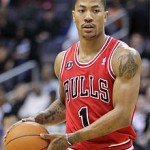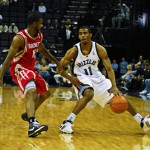Don’t get me wrong; Wall deserves an extension, and one that pays him eight figures per season. But he doesn’t deserve Chris Paul money. Or Derrick Rose money. Or Russell Westbrook money. That seems painfully obvious.
Wall shot a career-high 44.1 percent from the field last season, but that’s not an elite number. Nor was his 3-point shooting, which was 26.7 percent last season. He has only hit 49 treys in his entire career. Not really acceptable if you’re a complete player who legitimately deserves max money.
Jrue Holiday and Greivis Vasquez averaged more assists last season than Wall’s 7.6 per game, and 30 point guards who played at least 49 games – Wall’s total from 2012-2013 – had a better assist-to-turnover ratio than his 2.38.
Yes, thirty.
This is not to say that Wall isn’t a really good, improving player. His PER, Win Shares, offensive and defensive ratings, true shooting percentage and effective field-goal percentages were all career highs.
Win Shares don’t tell the complete story, not by a long shot. But his Basketball-Reference career similarity score ranks him alongside with point guards such as Sleepy Floyd and Sam Cassell. Very good players, yes. Max contract players? Certainly not.
Comparing Wall to Paul is unfair. Forget that Paul led the league in steals and averaged 2.3 more assists than Wall to go with a 4 percent jump in field-goal percentage and a 6 percent jump in 3-point shooting. Paul’s five-year, $107 million deal with the Clippers this summer is his third contract, while Wall is “negotiating” his second.
But comparing Wall to Rose and Westbrook after their third seasons is fair.
|
3rd Seasons |
Min |
Games |
FG% |
3FG% |
Pts |
Ast |
Reb |
Stl |
TO |
|
Wall |
32.7 |
49 |
44.1 |
26.7 |
18.5 |
7.6 |
4 |
1.3 |
3.2 |
|
Rose |
37.4 |
81 |
44.5 |
33.2 |
25 |
7.7 |
4.1 |
1 |
3.4 |
|
Westbrook |
34.7 |
82 |
44.2 |
33 |
21.9 |
8.2 |
4.6 |
1.9 |
3.9 |
If you look through the basic statistics of these three players after their third seasons in the league, you’ll notice that many of them are the same. But then look at the 3-point field goal percentage, games played and points per game and you’ll notice the difference. What really separates Rose and Westbrook from Wall comes when you look at the advanced numbers.
|
3rd seasons |
PER |
TS% |
EFG% |
O RTG |
D RTG |
Win Shares |
WS/48 |
|
Wall |
20.8 |
52.1 |
44.9 |
105 |
103 |
4.5 |
0.134 |
|
Rose |
23.5 |
55 |
48.5 |
113 |
103 |
13.1 |
0.208 |
|
Westbrook |
23.6 |
53.8 |
45.4 |
110 |
107 |
9.4 |
0.159 |
 In his third season, Rose won an MVP at age 22. That’s someone you give a max contract to. Rose had an astronomical 13.1 Win Shares that season, more than Wall has accumulated over his entire career. Rose averaged 25 points per game that season and shot 33.2 percent from three that season, numbers that Wall doesn’t seem capable of approaching.
In his third season, Rose won an MVP at age 22. That’s someone you give a max contract to. Rose had an astronomical 13.1 Win Shares that season, more than Wall has accumulated over his entire career. Rose averaged 25 points per game that season and shot 33.2 percent from three that season, numbers that Wall doesn’t seem capable of approaching.
Westbrook was already an All-Star by his third season with a really impressive 9.4 Win Shares for someone so young. Both players made deep playoff runs as unstoppable offensive forces. They’re you’re quintessential attack guards.
Wall? Never an All-Star. Never reached the playoffs. Never really considered a true offensive force. Deserving of a max contract after just three seasons like Rose and Westbrook? Not even a little.
 So who can we really compare Wall to among current point guards? Stephen Curry got $44 million over four years from Golden State, yet Wall isn’t close to the level Curry is on. Is Wall better than Memphis’ Mike Conley? Though Wall had better scoring, assist and PER numbers last season, Conley had better Win Share and shooting numbers and Conley is one of the top defensive players in the league.
So who can we really compare Wall to among current point guards? Stephen Curry got $44 million over four years from Golden State, yet Wall isn’t close to the level Curry is on. Is Wall better than Memphis’ Mike Conley? Though Wall had better scoring, assist and PER numbers last season, Conley had better Win Share and shooting numbers and Conley is one of the top defensive players in the league.
Wall is more in the class of fellow point guards Jrue Holiday and Ty Lawson. Both very good players, but hardly franchise cornerstones. Lawson is making $48 million over the next four, while Holiday is making $44 million. Here’s their numbers from last season, which are more in line with what Wall brings an NBA team at this point.
|
PG |
Min |
Games |
FG% |
3FG% |
Pts |
Ast |
Reb |
Stl |
TO |
|
Wall |
32.7 |
49 |
44.1 |
26.7 |
18.5 |
7.6 |
4 |
1.3 |
3.2 |
|
Holiday |
37.5 |
78 |
43.1 |
36.8 |
17.7 |
8 |
4.2 |
1.6 |
3.7 |
|
Lawson |
34.4 |
73 |
46.1 |
36.6 |
16.7 |
6.9 |
2.7 |
1.5 |
2.5 |
Look at how similar the basic numbers are, besides for the 3-point field goal percentage. Wall wins out when it comes to the advanced numbers, seen below, but you could tell that these three are basically in the same class of point guard.
|
PG |
PER |
TS% |
EFG% |
O RTG |
D RTG |
Win Shares |
WS/48 |
|
Wall |
20.8 |
52.1 |
44.9 |
105 |
103 |
4.5 |
0.134 |
|
Holiday |
16.7 |
49.6 |
46.6 |
99 |
107 |
3.3 |
0.055 |
|
Lawson |
17.9 |
54.9 |
50.5 |
113 |
109 |
7.4 |
0.141 |
Wall falls somewhere in line with that range, not at max level.
Was an extension at this appropriate monetary level even discussed between Wall and Washington GM Ernie Grunfeld? From Grunfeld’s standpoint, perhaps he had something to lose by approaching Wall in this way. What if Wall was insulted by the offer? Then you have a disgruntled franchise player who may not want to return, and a lot of money coming off the books after next season in Emeka Okafor and Trevor Ariza. By that logic, maybe appeasing Wall with a max offer was the way to go.
Though Wall isn’t deserving of a huge contract right now, maybe he turns into a max-level player. As a GM, I wouldn’t give out a monster contract based on potential, but it’s not unheard of. San Antonio did it with Tiago Splitter to an extent.
Grunfeld saw what we saw towards the end of last season, and that’s a potentially upper echelon backcourt pairing in Wall and Bradley Beal. Perhaps that was an impetus for the extension, but there seems to be a gap between how Washington values Wall and Wall’s actual value when compared to other point guards in the league.
There’s no question that the Washington Wizards need John Wall.
But over the next five years, this contract will ultimately test the theory that you overpay to keep the players you know you can’t afford to lose.
Shlomo Sprung is a Sheridan Hoops columnist specializing in advanced statistics and the way they explain what happens on the court. He is also the web editor of the Brooklyn Daily Eagle. A 2011 graduate of Columbia University’s Journalism School, he has previously worked for the New York Knicks, The Sporting News, Business Insider and other publications. His website is SprungOnSports.com. You can, and should, follow him on Twitter.
